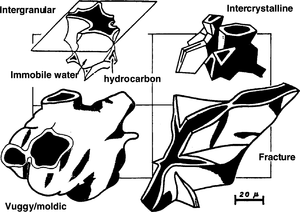Pore system fundamentals
| It has been suggested that this article be merged with [[::Pore systems|Pore systems]]. (Discuss) |
Porosity consists of relatively large voids, or pores, distributed among smaller passages called pore throats. A pore system is an aggregate of pores and pore throats that shares a similar morphology. These elements play a role in determining reservoir and seal petrophysics (the characteristic way that oil, gas, and water move through rocks). Figure 1 shows typical 3-D pore system geometries found in intergranular, intercrystalline, vuggy, or fractured rocks.

Critical elements of pore-system geometry
The pores of a rock occur between grains or crystals, in fractures, or in vugs. A rock's storage capacity is controlled by the size and number of pores. A rock's permeability (flow capacity) is controlled by the size, shape, and number of the pore throats (connections) per pore. Four critical elements of the geometry of a rock's pore system are
- Pore system shapes
- Pore and pore throat sizes
- Pore connectivity
- Ratio of pore throats to pores
See also
References
- ↑ Coalson, E. B., S. M. Goolsby, and M. H. Franklin, 1994, Subtle seals and fluid-flow barriers in carbonate rocks, in J.C. Dolson, M.L. Hendricks, and W.A. Wescott, eds., Unconformity Related Hydrocarbons in Sedimentary Sequences: RMAG Guidebook for Petroleum Exploration and Exploitation in Clastic and Carbonate Sediments, p. 45–58.